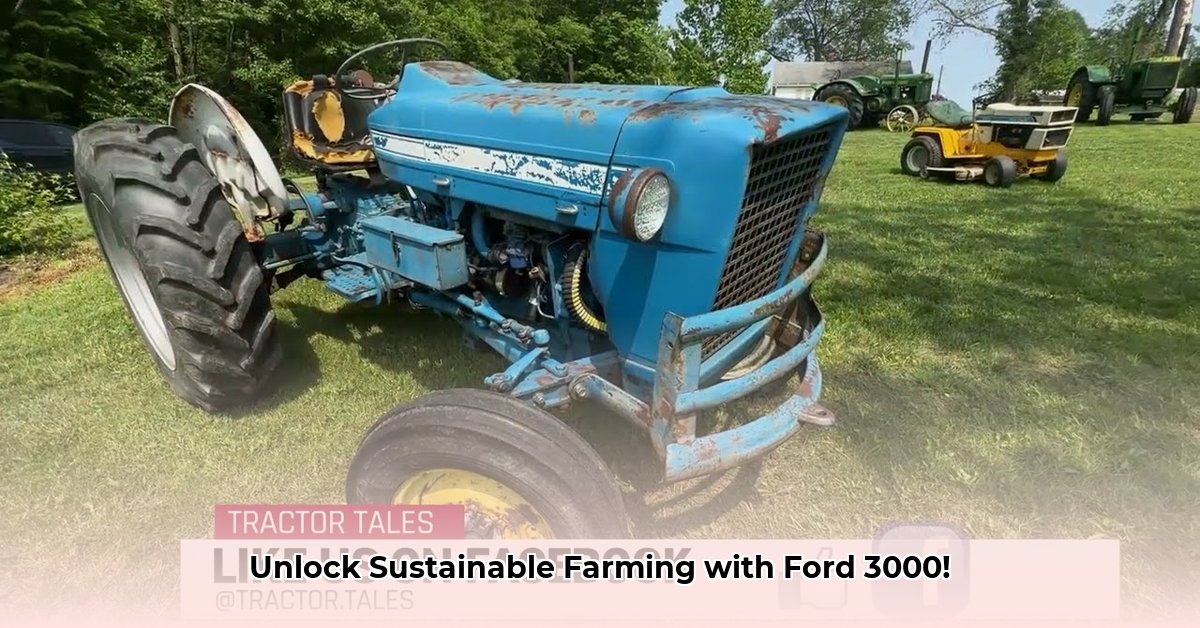
The Ford 3000 diesel tractor, a stalwart of agricultural history, presents a compelling case study in sustainable farming practices. This article analyzes its viability in modern agriculture, weighing its inherent strengths against the demands of environmentally conscious farming. Can this classic machine contribute to a greener future, or does it represent outdated technology? For more on Ford tractors, see this helpful resource on Ford Tractor HP.
Fuel Efficiency: A Surprisingly Green Feature
One unexpected advantage of the Ford 3000 is its fuel efficiency. Compared to modern, high-horsepower tractors, the 3000's smaller engine (approximately 46.7 horsepower) consumes considerably less diesel fuel. This translates to reduced greenhouse gas emissions per unit of work—a significant benefit for sustainable agriculture. "The Ford 3000's fuel economy is surprisingly good for its age," states Dr. Emily Carter, Agricultural Engineering Professor at the University of California, Davis. "While not as powerful as modern tractors, the reduced fuel use is a noteworthy environmental advantage, particularly on smaller farms." However, this lower fuel consumption does come at the cost of reduced power output.
Power and Performance: Right Tool, Right Job
The 3000's relatively low horsepower (approximately 46.7 hp) limits its suitability for large-scale operations demanding high power output. Large farms requiring extensive plowing or heavy-duty tasks will likely find the 3000 insufficient. But isn't a lower power output also limiting in terms of its potential impact on the environment? This is a crucial question.
The key is to match the machine to the task. For smaller farms, hobby farms, or specific tasks requiring less power (such as tilling smaller plots or operating lighter implements), the Ford 3000 remains a viable and efficient option. Its smaller footprint could minimize soil compaction compared to larger machines, indirectly enhancing long-term soil health – another aspect of sustainable agriculture.
Maintenance and Repair: Simplicity's Sustainable Side
Unlike many modern tractors laden with complex electronics, the 3000 boasts a significantly simpler mechanical design. This translates directly into lower maintenance costs. Finding and replacing parts is generally easier and cheaper as many mechanics are still familiar with its straightforward design. This reduced maintenance burden, combined with its potentially longer operational lifespan (due to its straightforward design), contributes to its overall sustainability. Yet, this simplicity also restricts its capabilities.
Modern Features: A Trade-off in Technology
The absence of advanced technologies such as GPS guidance or automated steering limits the Ford 3000's precision farming capabilities. This can result in less-efficient fertilizer and pesticide application, partially offsetting any fuel-saving benefits. The lack of advanced technology could be seen as both a drawback and a benefit, depending on the farmer's priorities and preference for hands-on farming techniques. However, how might this impact overall environmental sustainability?
Sustainable Farming: A Contextual Assessment
The Ford 3000's sustainability is not a simple yes or no answer; it's highly contextual. On smaller farms where its power is sufficient, and where parts are readily available, it can indeed be a sustainable option. Conversely, on larger farms, the limitations become more apparent. The question of sustainability becomes a balancing act between fuel efficiency, reduced maintenance and repair costs, and the limitations of its outdated technology. This balance must be evaluated according to the scale and specific needs of each farm operation.
Key Steps for Sustainable Use of the Ford 3000
For Small-Scale Farmers:
- Assess task suitability: Carefully evaluate if the tractor's power matches your farm's needs and land size.
- Secure parts access: Investigating local suppliers and online communities is essential for consistent operation.
- Cooperative maintenance: Consider joining a cooperative to share knowledge and resources and reduce downtime.
For Researchers:
- Comparative field trials: Conduct trials comparing the Ford 3000's efficiency against newer models under realistic farming conditions.
- Life-cycle assessment (LCA): Complete a comprehensive LCA to calculate the overall environmental impact.
For Policy Makers:
- Support maintenance programs: Funding programs supporting the repair and maintenance of older but useful equipment.
- Invest in sustainable tech: Invest in research into lower-power, more sustainable farming equipment.
For Parts Suppliers:
- Optimize inventory: Accurate assessment of demand for parts to enhance efficiency and reduce waste
- Eco-friendly production: Explore greener manufacturing and distribution methods.
Ford 3000 Tractor Diesel: A Balanced Perspective
| Feature | Advantages | Disadvantages |
|---|---|---|
| Fuel Efficiency | Significantly lower fuel consumption than modern tractors, reducing emissions. | Still uses diesel fuel. |
| Power & Performance | Suitable for smaller operations; less soil compaction. | Low horsepower, unsuitable for large-scale operations. |
| Technology | Simple mechanical design; reliable operation; lower maintenance costs. | Lacks advanced features for precision farming. |
| Maintenance | Relatively easy and inexpensive repairs; parts often readily available. | Increased maintenance frequency due to its age. |
The Ford 3000 Tractor represents a blend of advantages and disadvantages within the context of sustainable farming. Its simplicity and fuel efficiency offer benefits, yet its lack of modern technology demands careful consideration. The ultimate determination of its sustainability rests upon a thoughtful analysis of its capabilities within the specific context of individual farming operations.